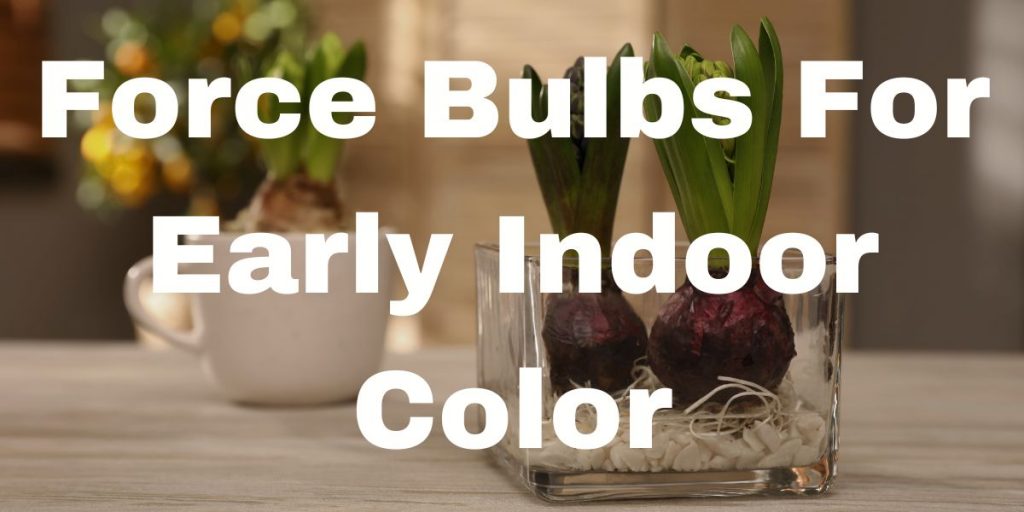This is a great project for any member of the family. It’s easy, rewarding and fun to force a few bulbs for early indoor color. Hyacinths, because of their distinctive fragrance, are one of the favorites for this project, but crocus and daffodils are other easy to force bulbs.
There are three common ways to force bulbs, in pebbles, with water and in soil. ‘Forcing’ means you encourage the bulbs to grow and bloom early, by planting them indoors and exposing the bulbs to warm temperatures. This process brings the bulbs into bloom weeks before they would normally bloom outdoors. So if you want to enjoy some early bulb flowers in your home this winter, here are a few ideas on ways to force them:
PEBBLES AND WATER – this is one of the easiest ways to force bulbs. Simply take a waterproof bowl, fill it with gravel or decorative stone. White rock is often used because its bright white makes a nice contrast with the bulbs and flowers. Firm the base of the bulbs into the pebbles, until they stand firmly on their own. Next fill water up to the base of the bulbs, but not high enough that it touches them. A plain glass bowl is best to use because you can see the water level, plus you can also watch the roots as they develop. (You want the roots to grow into the water, but you don’t want the bulb to sit in the water.) It’s that easy. The bulbs will flower better and the stems will usually be a little stronger if the bulbs are put into a dark spot for about four to six week before they are brought out into the warm temperatures and forced into bloom. This is a great way to force hyacinths, crocus, daffodils or early tulips.
WATER FORCING – this process is often used to start avocados. There is a glass vase you can buy called a ‘hyacinth glass’. It is upright with a tapered neck, then it widens out just enough at the top to hold a hyacinth bulb. If you use the hyacinth glass all you do is fill the container with water, up to the tapered neck, sit the bulb on the widened mouth of the container and it’s ready to be forced. Again be certain the bottom of the bulb does not come into contact with the water. There should be about 1/8 of an inch between the water and the bottom of the bulbs.
Hyacinth bulbs can also be forced by simply inserting toothpicks into four sides of the bulbs. Next use a regular drinking glass and set the toothpicks on the rim of the glass. Then fill water up-to but not touching the base of the hyacinth bulb. (This is how the avocado’s are usually started.)
With the water method it is a good practice to put the bulbs in a dark, cool place for about four or five weeks, before bringing them out to start forcing the bulbs. This conditioning period is to encourage root development first.
POTTING BULBS IN SOIL – this is probably the most popular way to force bulbs, but certainly not the easiest. Simply pot the bulbs in clay or plastic pots, using a commercial potting mix. A five or six inch pot will hold about three average-sized tulips, daffodils or hyacinth bulbs. A seven-inch pot will hold about four or five bulbs. If you are forcing crocus there should be space for two or three times that many bulbs.
Fill the pot two-third full of the potting mix, then place the bulbs in position, and cover with additional soil. If the top of the bulb is exposed, that’s all right.
Next bury the pots in the ground outside, covering them with about two to four inches of soil. Leave them there for about two months. During that period they will have developed a nice root system and should be ready to bring back inside for forcing.
When you bring the bulbs indoors keep them in a room where the temperatures range between 50 and 60 degrees. If the temperatures are kept too warm the bulb foliage will get too tall and leggy. Once the bulbs begin to form their flower stalks, they can be brought into warmer temperatures and enjoyed by all.
After the bulbs have finished flowering they can be planted directly into the garden. Do not use these same bulbs for forcing again next season, because so much of the bulbs energy has been used in the forcing process.
